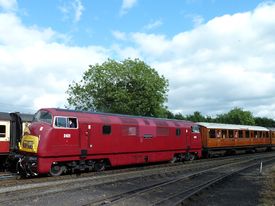BR Class 42 D821 Greyhound
| BR Class 42 D821 Greyhound | |
|---|---|
 D821 Greyhound at Bridgnorth in 2011 | |
| Built By | BR Swindon Works |
| Configuration | B-B |
| Power type | Diesel Hydraulic |
| Status | Operational |
| Loco Number | D821 |
| History | |
| Built | 1960 |
| Designed By | British Railways |
| Type | Class 42 |
| 1973 | Purchased by precursors of the Diesel Traction Group |
| 1981 | Overhauled at Swindon |
| 1991 | Arrived on SVR |
| 2014 | Overhaul began at Old Oak Common |
| 2018 | Returned to traffic |
| Technical | |
| Length | 60ft |
| Weight | 78t |
The Post-War BR Modernisation Plan called for the introduction of a range of Diesel locomotives. Although the majority were diesel electric, the Western Region at Swindon developed the B-B diesel-hydraulic Class 42 ‘Warship’ class (all bar two of the class being named after Royal Naval vessels). D821 is one of two preserved examples of the 38 originally built.[1]
The last HMS Greyhound (H05) was a G-class destroyer, launched in 1935 and sunk by German dive bombers in 1941 in the battle for Crete, with the loss of 100 lives.[2] An earlier HMS Greyhound, a Greyhound-class destroyer, also saw service from 1900 to 1919. A number of other Naval vessels have also carried the name.[1]
Contents
D821 in service
D821 Greyhound was outshopped from BR Swindon Works in May 1960, and served mainly at Plymouth Laira with brief spells at Newton Abbot.[3] While in service D821 carried various liveries including green, maroon and blue. She was withdrawn from service on 3 December 1972, with more than 1 million miles of main line working.[4]
D821 in preservation
D821 was bought by members of the Diesel Traction Group, becoming the first main line diesel to be sold for preservation. In May 1973 D821 moved from Laira to Didcot, another first as a preserved private owner loco running on the main line under its own power, before the ban on such running was imposed. It moved again in the following year to the private Kings Meadow sidings just east of Reading station, in the Reading Gas Works site, where it was a notable sight from trains passing on the nearby Great Western main line. From 1975 it was in the company of the DTG's BR Class 35 D7029.
Between February 1977 and April 1981 the locomotive underwent an overhaul at Swindon, and then moved to the North Yorkshire Moors Railway. She finally arrived on the SVR in September 1991.[4]
An overhaul commenced in 2014.[5] After a long period under repair at Old Oak Common (OOC) she returned to the SVR after the OOC open day in September 2017, before returning to use in April 2018 in time for the following month's Spring Diesel Festival.
2021/22 saw extensive bodywork repairs, replacement of primary suspension springs, attention to the brake system and a repaint into BR Blue with full yellow ends[6].
See also
Diesel Locomotives
SVR-based diesel locomotives visiting other events
Diesel Traction Group
Locomotives running under different identities
References
- ↑ 1.0 1.1 Wikipedia
- ↑ Casualty Search (Retrieved 24 July 2019)
- ↑ BR Database
- ↑ 4.0 4.1 SVR Stock Book 9th Edition
- ↑ SVR meet the Locomotives
- ↑ SVR News 218, Summer 2022, p. 23
Links
BR Class 42 on Wikipedia
Diesel Traction Group website
| ||||||||||||||||||||||||||||||||||||||||||||||||||||||||||||||||||||||||